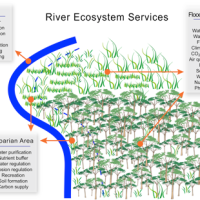An insider’s view of Convention on Biological Diversity Conference 10, Nagoya, Japan
 This week’s post is written by BioFresh partner Dr Hendrik Segers from the Royal Belgian Institute of Natural Sciences. Dr. Segers co-ordinates the Belgian Biodiversity Platform, which promotes effective collection and accessibility of global biodiversity data. Dr. Segers’ research interests surround the biodiversity and biogeography of freshwater systems, and has published more than 130 scientific papers, including 70+ in ISI journals, on the subject.
This week’s post is written by BioFresh partner Dr Hendrik Segers from the Royal Belgian Institute of Natural Sciences. Dr. Segers co-ordinates the Belgian Biodiversity Platform, which promotes effective collection and accessibility of global biodiversity data. Dr. Segers’ research interests surround the biodiversity and biogeography of freshwater systems, and has published more than 130 scientific papers, including 70+ in ISI journals, on the subject.
Dr Segers was present at the Convention on Biological Diversity Conference of Parties 10 in Nayoga, Japan held in October 2010. Here he offers a unique insider’s insight into the inner workings of the talks.
After the failure of the last UNFCCC Conference of the Parties in Copenhagen in 2009, many observers worried that this marked a general lack of confidence in the effectiveness of intergovernmental processes to deal with environmental issues. Moreover, the stakes for the 10th Conference of the Parties of the Convention on Biological Diversity were unusually high, which was neither an element that inspired much confidence. This 10th Conference of the Parties, or, short, Cop 10, had to consider a relatively large number of widely ranging subjects, going from household issues to a series of in-depth reviews of Programmes of Work, including such contentious ones as Protected Areas, Marine and Coastal biodiversity, and Biodiversity and Climate Change. On top of those regular ones, there were three more issues that could easily have gone awry.
First, an agreement had to be negotiated on a protocol to deal with Access to Genetic Resources and the Fair and Equitable Sharing of Benefits Arising from their Utilization, or the ABS protocol. After about seven years of painstaking negotiations, Parties (countries that have ratified the CBD) were hard pressed to conclude on a protocol that would regulate the access to genetic resources – mostly in the interest of developed countries – and the sharing of the benefits arising from their utilization – a concern for, mostly, developing countries. I can illustrate the complexity of the ABS negotiations by referring to the case of derivatives: to what extent should a molecule be considered a Genetic Resource under the terms of the protocol? Does changing a few atoms in a molecule that otherwise is found in bacteria dwelling the depths of a tropical swamp make it an artificial substance, that can therefore at leisure be commercialized by a pharmaceutical company?
A second heavily debated issue was the strategic plan for the post-2010 period implementation of the Convention. This plan includes some – more or less strictly circumscribed – targets and deadlines for the conservation and sustainable use of biodiversity. Goals on freshwater biodiversity are included in targets 111 and 142. That coming to such an agreement is a difficult process should not surprise anyone.
Last but not least, resources have to be made available to make all this possible. Bearing the global economic crisis in mind, arriving at a Strategy for Resource Mobilization that balances the interests of developed countries with those of the G77 and upcoming economies such as Brazil and China was no sinecure.
With all this in mind, it was clear that the Nagoya COP of CBD was not expected to be a walk in the park. The international press had so much as declared it a lost cause even before the start of the meeting, which of course did not inspire much confidence. Indeed, the mood swung from positive to negative and back during the fourteen long days and nights of the meeting, during plenaries, working group meetings, informal contact group meetings, friends of the Chair meetings, the high-level ministerial segment , and, in parallel to those, regional coordination meetings, e.g., amongst EU members states under the Belgian presidency. This went on until and during the final plenary on Friday evening, where exhausted negotiators were seen to frantically run from one Party to another to convince, plead, or explain complex package deals. Until, finally, around 3 AM on Saturday morning, the Chair could finally adopt a full set of decisions, including the Nagoya protocol on ABS, a Strategic Plan for the post 2010 period, and a Strategy for Resource Mobilization, and adjourn a successful CBD COP 10.
If one reads through all the decisions of this COP, one will certainly find weaknesses, but also positive points. My feeling is that a reasonably acceptable balance was struck between ambition and realism, and between the interests of both developed as well as developing country Parties. In fact, in hindsight, the mere fact that a consensus was reached already exemplifies the sense of responsibility and urgency that will be needed even more to tackle the global environmental crisis that is upon us today. As I write this, the CPP16 of UNFCCC COP in Cancun, Mexico, has just concluded and it is good to see that negotiators there appear to have been inspired by the success of CBD COP 10.
H. Segers
Further reading:
http://www.cbd.int/nagoya/outcomes/ for the unedited outcomes of the meeting;
http://www.iisd.ca/biodiv/cop10/: report on COP10 by IISD reporting services
Notes:
1 Target 11: By 2020, at least 17 per cent of terrestrial and inland water, and 10 per cent of coastal and marine areas, especially areas of particular importance for biodiversity and ecosystem services, are conserved through effectively and equitably managed, ecologically representative and well connected systems of protected areas and other effective area-based conservation measures, and integrated into the wider landscape and seascapes.
2 Target 14: By 2020, ecosystems that provide essential services, including services related to water, and contribute to health, livelihoods and well-being, are restored and safeguarded, taking into account the needs of women, indigenous and local communities, and the poor and vulnerable.














